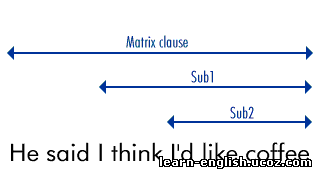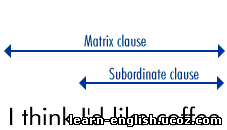11 Clauses and sentences
So far we have been looking at phrases more or less in isolation. In real use, of course, they occur in isolation only in very restricted circumstances. For example, we find isolated NPs in public signs and notices:
[Exit]
[Sale]
[Restricted Area]
[Hyde Park]
We sometimes use isolated phrases in spoken English, especially in responses to questions:
Q: What would you like to drink?
A: [NP Coffee]
Q: How are you today?
A: [AP Fine]
Q: Where did you park the car?
A: [PP Behind the house]
In more general use, however, phrases are integrated into longer units, which we call CLAUSES:
Q: What would you like to drink?
A: [I'd like coffee]
Q: How are you today?
A: [I'm fine]
Q: Where did you park the car?
A: [I parked the car behind the house]
11.1 The Clause Hierarchy
The clause I'd like coffee is a SUBORDINATE CLAUSE within the sentence I think I'd like coffee. We refer to this larger clause as the MATRIX CLAUSE:
The matrix clause is not subordinate to any other, so it is, in fact, co-extensive with the sentence.
We say that the matrix clause is SUPERORDINATE to the subordinate clause.
The terms subordinate and superordinate are relative terms. They describe the relationship between clauses in what is called the CLAUSE HIERARCHY. We can illustrate what this means by looking at a slightly more complicated example:
He said I think I'd like coffee
Here the matrix clause is:
He said I think I'd like coffee
This matrix clause contains two subordinate clauses, which we'll refer to as Sub1 and Sub2:

Sub1 is both subordinate and superordinate. It is subordinate in relation to the matrix clause, and it is superordinate in relation to Sub2.
Subordinate and superordinate, then, are not absolute terms. They describe how clauses are arranged hierarchically relative to each other.
We can bracket and label clauses in the same way as phrases. We will use the following abbreviations:
Matrix Clause: MC
Subordinate Clause: SubC
Applying these labels and brackets to our first example, we get:
[MC I think [SubC I'd like coffee]]
Just as we've seen with phrases, we can have embedding in clauses too. Here, the subordinate clause is embedded within the matrix clause.
There is a greater degree of embedding in our second example, where there are two subordinate clauses, one within the other:
[MC He said [SubC I think [SubC I'd like coffee]]]
11.2 Finite and Nonfinite Clauses
As a working definition, let us say that clauses contain at least a verb phrase:
[MC [VP Stop]]
[MC David [VP composed an aria] when he was twelve]
[MC My solicitor [VP sent me a letter] yesterday]
As these examples show, clauses can also contain many other elements, but for now we will concentrate on the VP. We have already seen that verbs (and therefore the VPs that contain them) are either FINITE or NONFINITE, so we can use this distinction to classify clauses. Clauses are either finite or nonfinite.
Finite verb phrases carry tense, and the clauses containing them are FINITE CLAUSES:
[1] She writes home every day (finite clause -- present tense verb)
[2] She wrote home yesterday (finite clause -- past tense verb)
On the other hand, nonfinite verb phrases do not carry tense. Their main verb is either a to-infinitive [3], a bare infinitive [4], an -ed form [5], or an -ing form [6]:
[3] David loves [to play the piano]
[4] We made [David play the piano]
[5] [Written in 1864], it soon became a classic
[6] [Leaving home] can be very traumatic
These are NONFINITE CLAUSES.
Matrix clauses are always finite, as in [1] and [2]. However, they may contain nonfinite subordinate clauses within them. For example:
[MC David loves [SubC to play the piano]]
Here we have a finite matrix clause -- its main verb loves has the present tense form. Within it, there is a nonfinite subordinate clause to play the piano -- its main verb play has the to-infinitive form.
On the other hand, subordinate clauses can be either finite or nonfinite:
Finite: He said [SubC that they stayed at a lovely hotel] -- past tense
Nonfinite: I was advised [SubC to sell my old car] -- to-infinitive





